MBA 705 Macy's Business Implementation: Financial Analysis & Funding
VerifiedAdded on 2023/04/23
|11
|2281
|63
Project
AI Summary
This project outlines a business implementation plan for Macy's, focusing on a detailed financial analysis and funding strategy. It includes market analysis, marketing and operational strategies, and a comprehensive financial plan with forecasted income statements, cash flow statements, and balance sheets. The analysis projects costs, revenue streams, and net present value (NPV) from launch until two years after the breakeven point, incorporating a budget, assessment of assets and liabilities, anticipated funding sources, and associated capital costs. Key financial metrics such as NPV, IRR, and payback period are calculated to assess the project's profitability and internal rate of return, demonstrating a strong return on investment. The study provides a clear roadmap for Macy's business development, highlighting potential for growth and profitability.
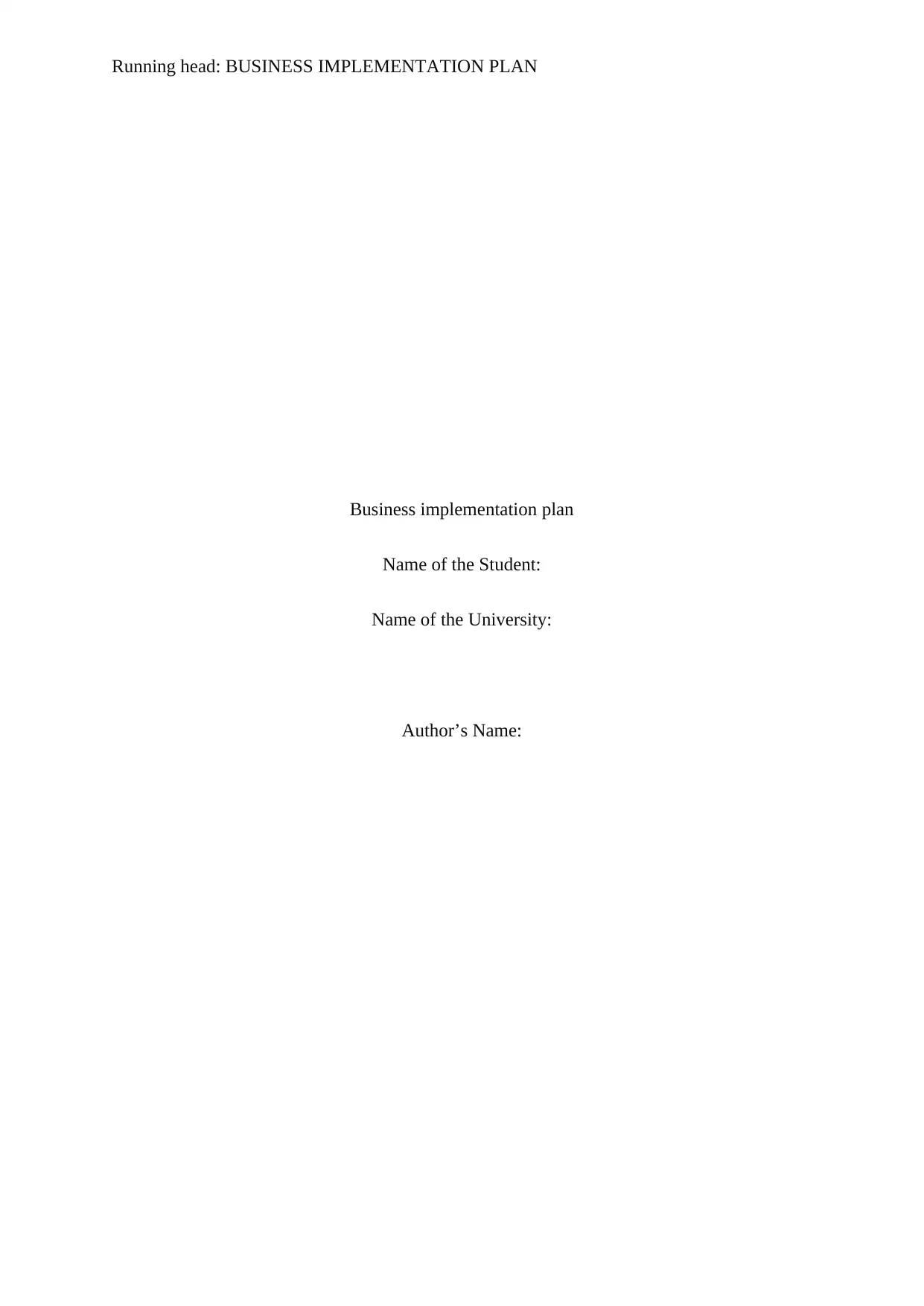
Running head: BUSINESS IMPLEMENTATION PLAN
Business implementation plan
Name of the Student:
Name of the University:
Author’s Name:
Business implementation plan
Name of the Student:
Name of the University:
Author’s Name:
Paraphrase This Document
Need a fresh take? Get an instant paraphrase of this document with our AI Paraphraser
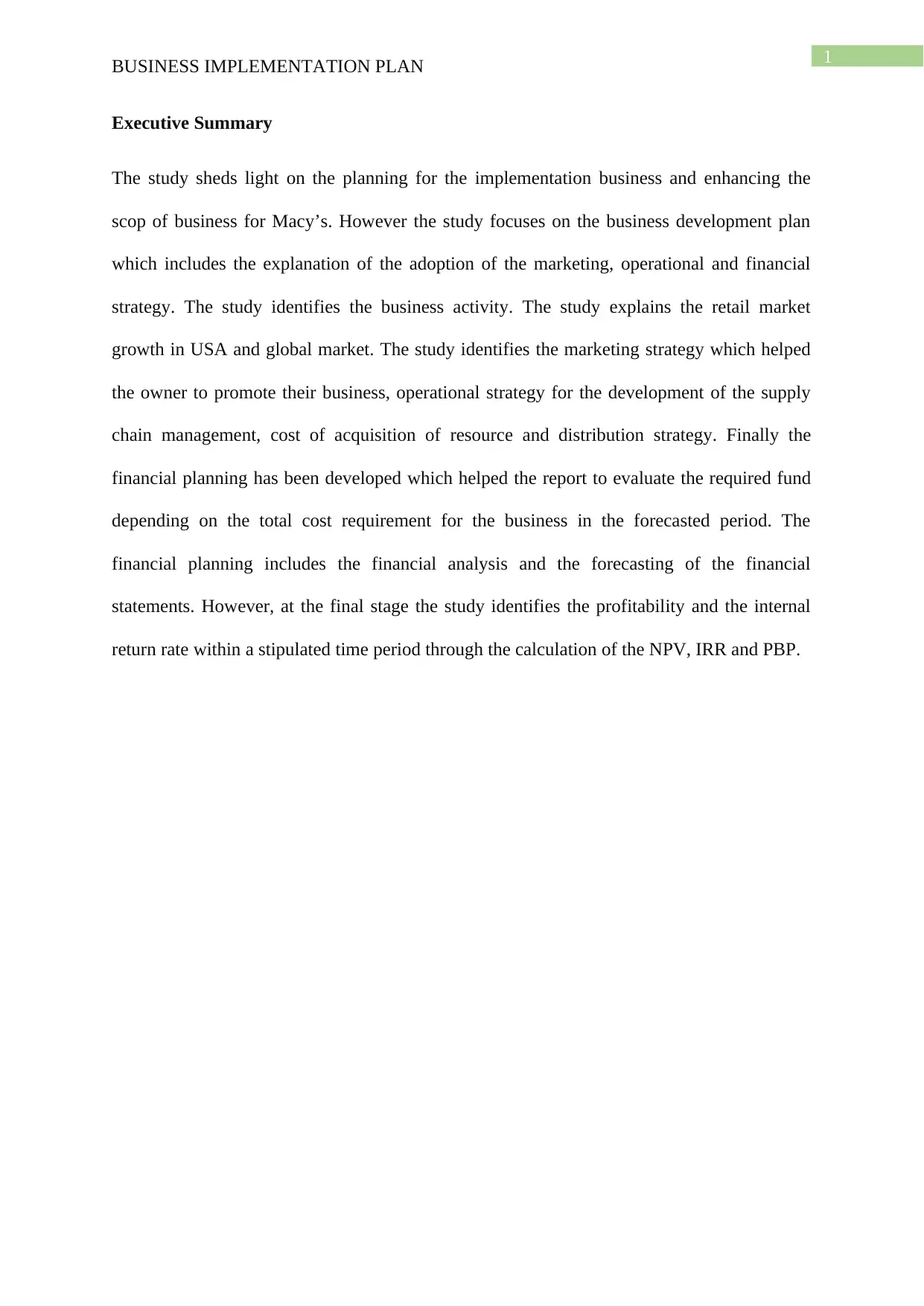
1
BUSINESS IMPLEMENTATION PLAN
Executive Summary
The study sheds light on the planning for the implementation business and enhancing the
scop of business for Macy’s. However the study focuses on the business development plan
which includes the explanation of the adoption of the marketing, operational and financial
strategy. The study identifies the business activity. The study explains the retail market
growth in USA and global market. The study identifies the marketing strategy which helped
the owner to promote their business, operational strategy for the development of the supply
chain management, cost of acquisition of resource and distribution strategy. Finally the
financial planning has been developed which helped the report to evaluate the required fund
depending on the total cost requirement for the business in the forecasted period. The
financial planning includes the financial analysis and the forecasting of the financial
statements. However, at the final stage the study identifies the profitability and the internal
return rate within a stipulated time period through the calculation of the NPV, IRR and PBP.
BUSINESS IMPLEMENTATION PLAN
Executive Summary
The study sheds light on the planning for the implementation business and enhancing the
scop of business for Macy’s. However the study focuses on the business development plan
which includes the explanation of the adoption of the marketing, operational and financial
strategy. The study identifies the business activity. The study explains the retail market
growth in USA and global market. The study identifies the marketing strategy which helped
the owner to promote their business, operational strategy for the development of the supply
chain management, cost of acquisition of resource and distribution strategy. Finally the
financial planning has been developed which helped the report to evaluate the required fund
depending on the total cost requirement for the business in the forecasted period. The
financial planning includes the financial analysis and the forecasting of the financial
statements. However, at the final stage the study identifies the profitability and the internal
return rate within a stipulated time period through the calculation of the NPV, IRR and PBP.
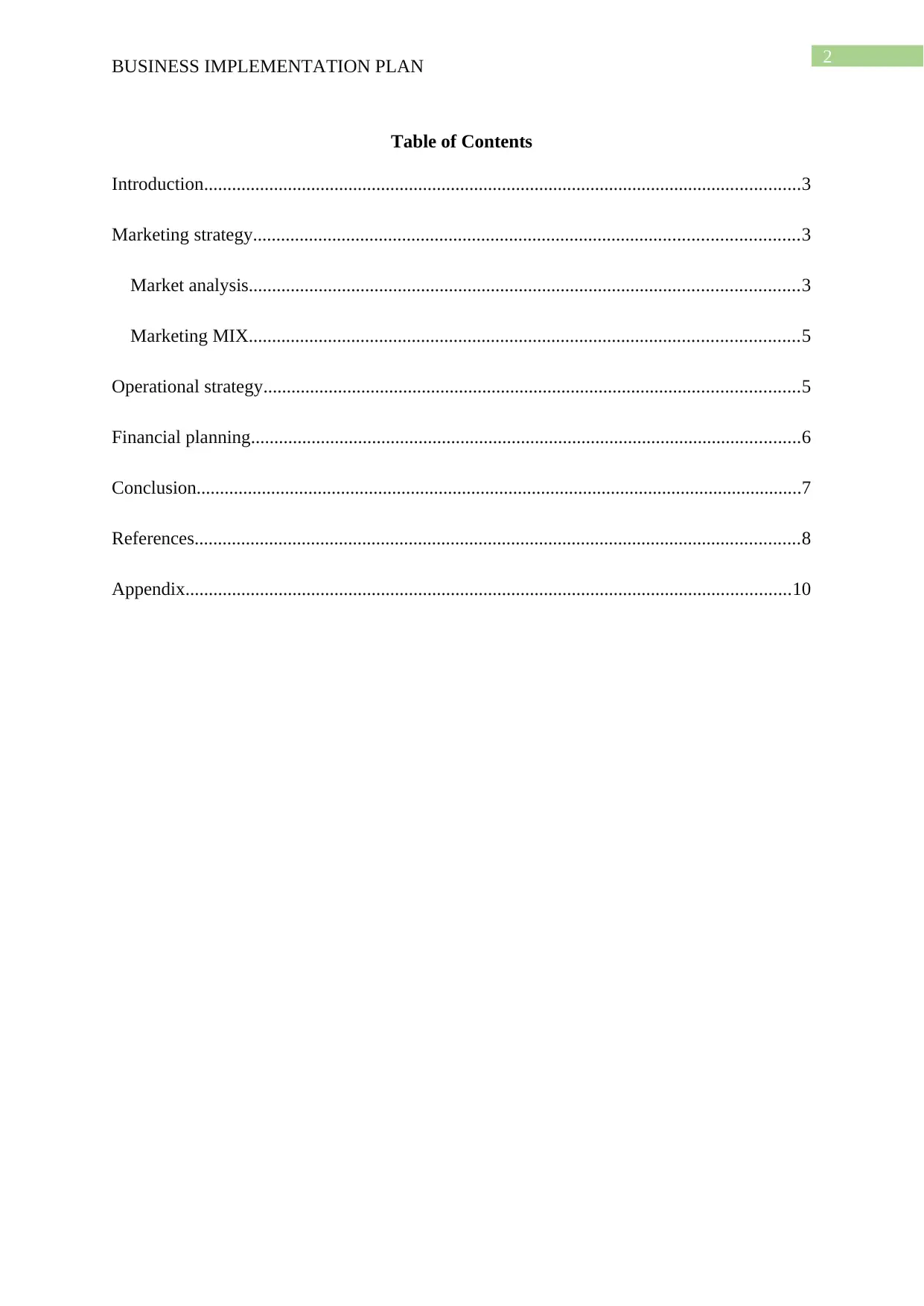
2
BUSINESS IMPLEMENTATION PLAN
Table of Contents
Introduction................................................................................................................................3
Marketing strategy.....................................................................................................................3
Market analysis......................................................................................................................3
Marketing MIX......................................................................................................................5
Operational strategy...................................................................................................................5
Financial planning......................................................................................................................6
Conclusion..................................................................................................................................7
References..................................................................................................................................8
Appendix..................................................................................................................................10
BUSINESS IMPLEMENTATION PLAN
Table of Contents
Introduction................................................................................................................................3
Marketing strategy.....................................................................................................................3
Market analysis......................................................................................................................3
Marketing MIX......................................................................................................................5
Operational strategy...................................................................................................................5
Financial planning......................................................................................................................6
Conclusion..................................................................................................................................7
References..................................................................................................................................8
Appendix..................................................................................................................................10
⊘ This is a preview!⊘
Do you want full access?
Subscribe today to unlock all pages.

Trusted by 1+ million students worldwide
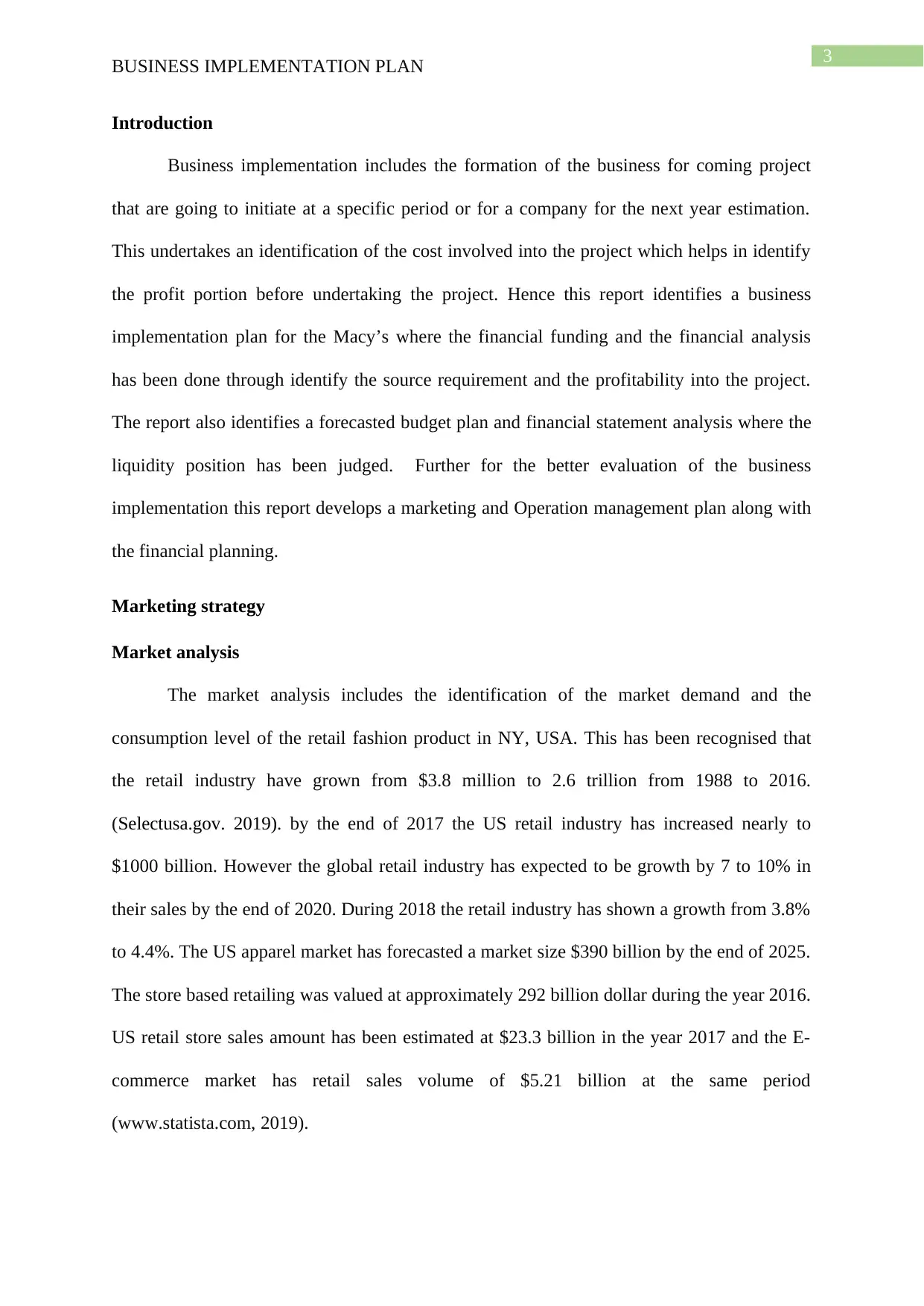
3
BUSINESS IMPLEMENTATION PLAN
Introduction
Business implementation includes the formation of the business for coming project
that are going to initiate at a specific period or for a company for the next year estimation.
This undertakes an identification of the cost involved into the project which helps in identify
the profit portion before undertaking the project. Hence this report identifies a business
implementation plan for the Macy’s where the financial funding and the financial analysis
has been done through identify the source requirement and the profitability into the project.
The report also identifies a forecasted budget plan and financial statement analysis where the
liquidity position has been judged. Further for the better evaluation of the business
implementation this report develops a marketing and Operation management plan along with
the financial planning.
Marketing strategy
Market analysis
The market analysis includes the identification of the market demand and the
consumption level of the retail fashion product in NY, USA. This has been recognised that
the retail industry have grown from $3.8 million to 2.6 trillion from 1988 to 2016.
(Selectusa.gov. 2019). by the end of 2017 the US retail industry has increased nearly to
$1000 billion. However the global retail industry has expected to be growth by 7 to 10% in
their sales by the end of 2020. During 2018 the retail industry has shown a growth from 3.8%
to 4.4%. The US apparel market has forecasted a market size $390 billion by the end of 2025.
The store based retailing was valued at approximately 292 billion dollar during the year 2016.
US retail store sales amount has been estimated at $23.3 billion in the year 2017 and the E-
commerce market has retail sales volume of $5.21 billion at the same period
(www.statista.com, 2019).
BUSINESS IMPLEMENTATION PLAN
Introduction
Business implementation includes the formation of the business for coming project
that are going to initiate at a specific period or for a company for the next year estimation.
This undertakes an identification of the cost involved into the project which helps in identify
the profit portion before undertaking the project. Hence this report identifies a business
implementation plan for the Macy’s where the financial funding and the financial analysis
has been done through identify the source requirement and the profitability into the project.
The report also identifies a forecasted budget plan and financial statement analysis where the
liquidity position has been judged. Further for the better evaluation of the business
implementation this report develops a marketing and Operation management plan along with
the financial planning.
Marketing strategy
Market analysis
The market analysis includes the identification of the market demand and the
consumption level of the retail fashion product in NY, USA. This has been recognised that
the retail industry have grown from $3.8 million to 2.6 trillion from 1988 to 2016.
(Selectusa.gov. 2019). by the end of 2017 the US retail industry has increased nearly to
$1000 billion. However the global retail industry has expected to be growth by 7 to 10% in
their sales by the end of 2020. During 2018 the retail industry has shown a growth from 3.8%
to 4.4%. The US apparel market has forecasted a market size $390 billion by the end of 2025.
The store based retailing was valued at approximately 292 billion dollar during the year 2016.
US retail store sales amount has been estimated at $23.3 billion in the year 2017 and the E-
commerce market has retail sales volume of $5.21 billion at the same period
(www.statista.com, 2019).
Paraphrase This Document
Need a fresh take? Get an instant paraphrase of this document with our AI Paraphraser
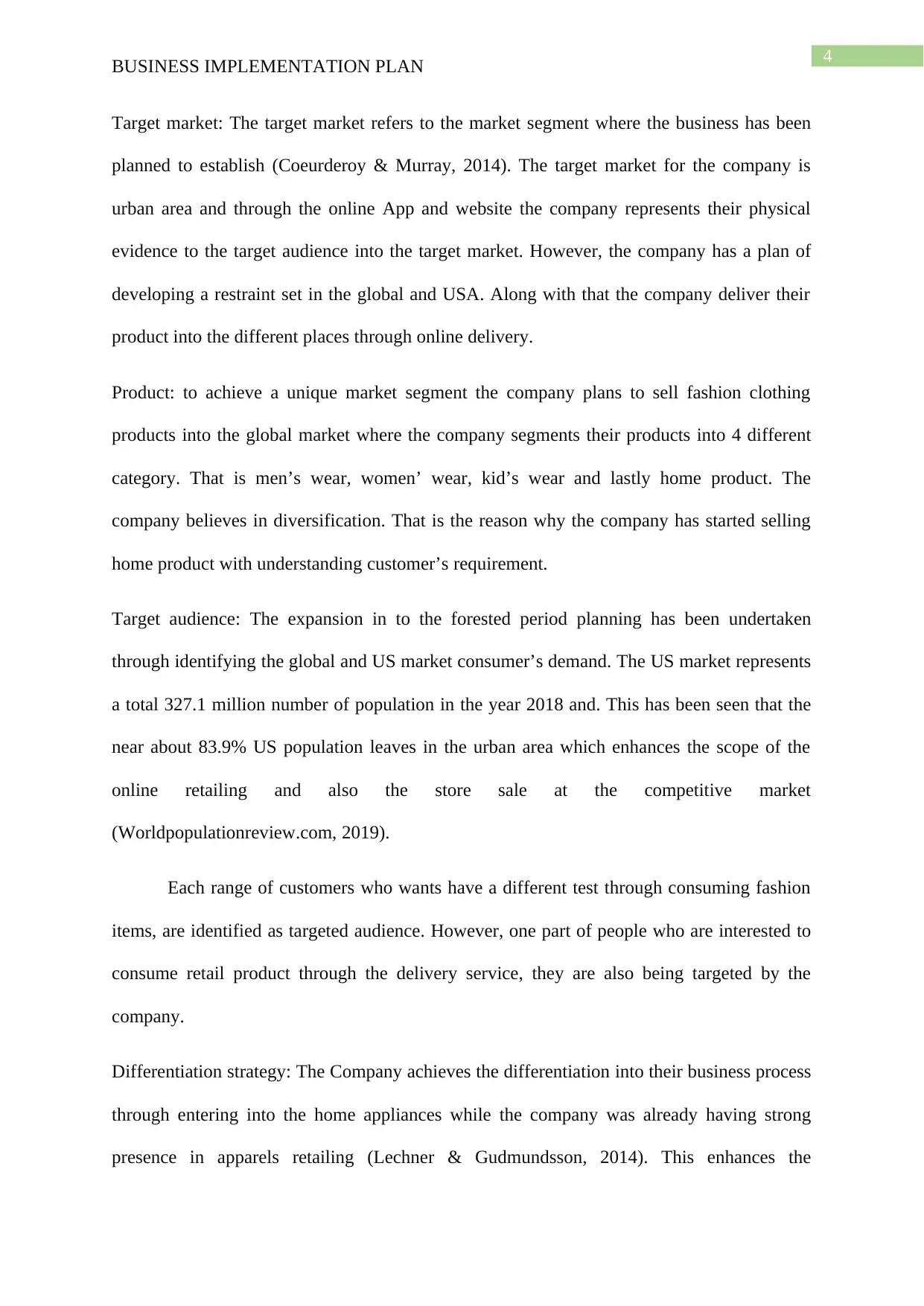
4
BUSINESS IMPLEMENTATION PLAN
Target market: The target market refers to the market segment where the business has been
planned to establish (Coeurderoy & Murray, 2014). The target market for the company is
urban area and through the online App and website the company represents their physical
evidence to the target audience into the target market. However, the company has a plan of
developing a restraint set in the global and USA. Along with that the company deliver their
product into the different places through online delivery.
Product: to achieve a unique market segment the company plans to sell fashion clothing
products into the global market where the company segments their products into 4 different
category. That is men’s wear, women’ wear, kid’s wear and lastly home product. The
company believes in diversification. That is the reason why the company has started selling
home product with understanding customer’s requirement.
Target audience: The expansion in to the forested period planning has been undertaken
through identifying the global and US market consumer’s demand. The US market represents
a total 327.1 million number of population in the year 2018 and. This has been seen that the
near about 83.9% US population leaves in the urban area which enhances the scope of the
online retailing and also the store sale at the competitive market
(Worldpopulationreview.com, 2019).
Each range of customers who wants have a different test through consuming fashion
items, are identified as targeted audience. However, one part of people who are interested to
consume retail product through the delivery service, they are also being targeted by the
company.
Differentiation strategy: The Company achieves the differentiation into their business process
through entering into the home appliances while the company was already having strong
presence in apparels retailing (Lechner & Gudmundsson, 2014). This enhances the
BUSINESS IMPLEMENTATION PLAN
Target market: The target market refers to the market segment where the business has been
planned to establish (Coeurderoy & Murray, 2014). The target market for the company is
urban area and through the online App and website the company represents their physical
evidence to the target audience into the target market. However, the company has a plan of
developing a restraint set in the global and USA. Along with that the company deliver their
product into the different places through online delivery.
Product: to achieve a unique market segment the company plans to sell fashion clothing
products into the global market where the company segments their products into 4 different
category. That is men’s wear, women’ wear, kid’s wear and lastly home product. The
company believes in diversification. That is the reason why the company has started selling
home product with understanding customer’s requirement.
Target audience: The expansion in to the forested period planning has been undertaken
through identifying the global and US market consumer’s demand. The US market represents
a total 327.1 million number of population in the year 2018 and. This has been seen that the
near about 83.9% US population leaves in the urban area which enhances the scope of the
online retailing and also the store sale at the competitive market
(Worldpopulationreview.com, 2019).
Each range of customers who wants have a different test through consuming fashion
items, are identified as targeted audience. However, one part of people who are interested to
consume retail product through the delivery service, they are also being targeted by the
company.
Differentiation strategy: The Company achieves the differentiation into their business process
through entering into the home appliances while the company was already having strong
presence in apparels retailing (Lechner & Gudmundsson, 2014). This enhances the
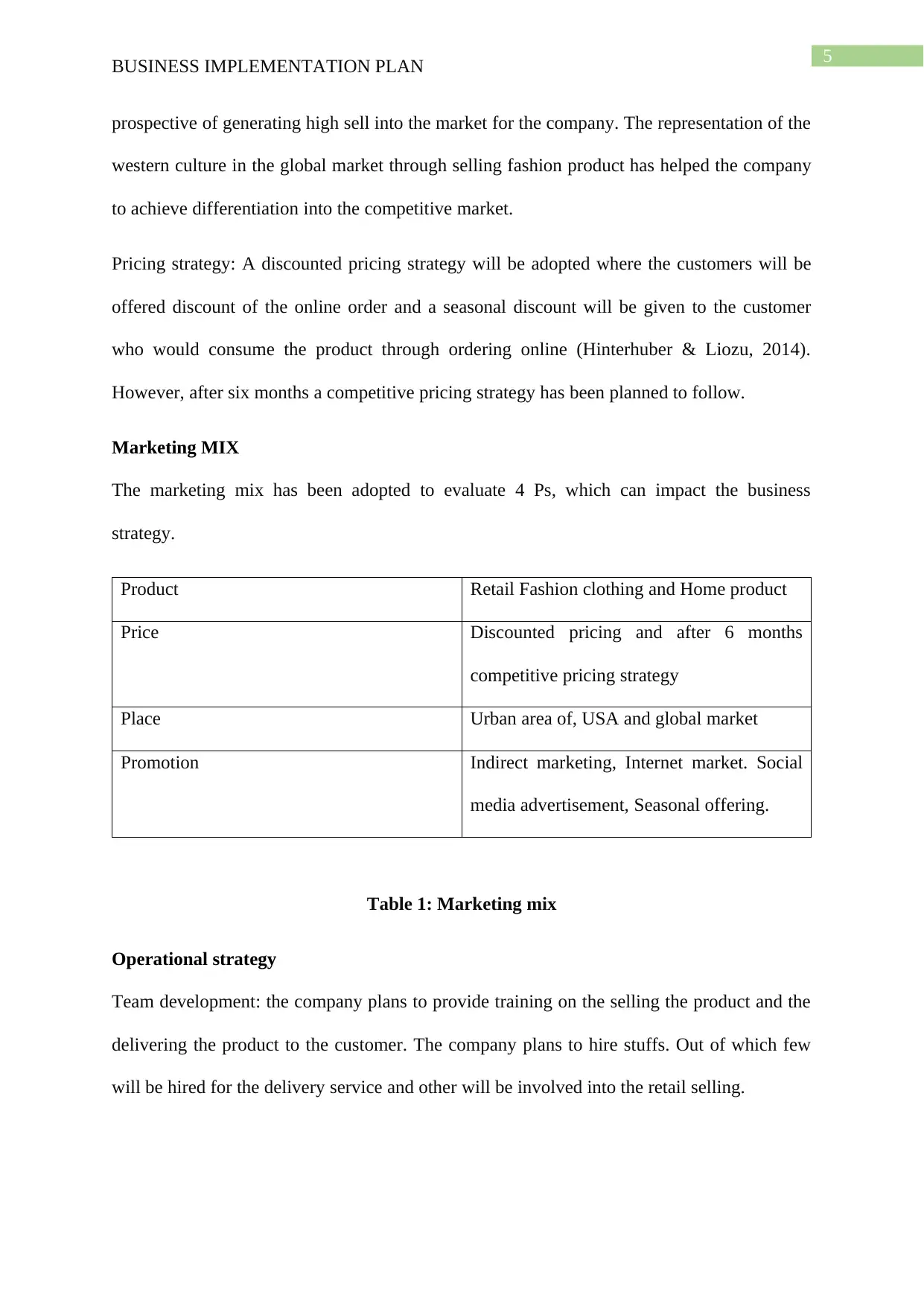
5
BUSINESS IMPLEMENTATION PLAN
prospective of generating high sell into the market for the company. The representation of the
western culture in the global market through selling fashion product has helped the company
to achieve differentiation into the competitive market.
Pricing strategy: A discounted pricing strategy will be adopted where the customers will be
offered discount of the online order and a seasonal discount will be given to the customer
who would consume the product through ordering online (Hinterhuber & Liozu, 2014).
However, after six months a competitive pricing strategy has been planned to follow.
Marketing MIX
The marketing mix has been adopted to evaluate 4 Ps, which can impact the business
strategy.
Product Retail Fashion clothing and Home product
Price Discounted pricing and after 6 months
competitive pricing strategy
Place Urban area of, USA and global market
Promotion Indirect marketing, Internet market. Social
media advertisement, Seasonal offering.
Table 1: Marketing mix
Operational strategy
Team development: the company plans to provide training on the selling the product and the
delivering the product to the customer. The company plans to hire stuffs. Out of which few
will be hired for the delivery service and other will be involved into the retail selling.
BUSINESS IMPLEMENTATION PLAN
prospective of generating high sell into the market for the company. The representation of the
western culture in the global market through selling fashion product has helped the company
to achieve differentiation into the competitive market.
Pricing strategy: A discounted pricing strategy will be adopted where the customers will be
offered discount of the online order and a seasonal discount will be given to the customer
who would consume the product through ordering online (Hinterhuber & Liozu, 2014).
However, after six months a competitive pricing strategy has been planned to follow.
Marketing MIX
The marketing mix has been adopted to evaluate 4 Ps, which can impact the business
strategy.
Product Retail Fashion clothing and Home product
Price Discounted pricing and after 6 months
competitive pricing strategy
Place Urban area of, USA and global market
Promotion Indirect marketing, Internet market. Social
media advertisement, Seasonal offering.
Table 1: Marketing mix
Operational strategy
Team development: the company plans to provide training on the selling the product and the
delivering the product to the customer. The company plans to hire stuffs. Out of which few
will be hired for the delivery service and other will be involved into the retail selling.
⊘ This is a preview!⊘
Do you want full access?
Subscribe today to unlock all pages.

Trusted by 1+ million students worldwide
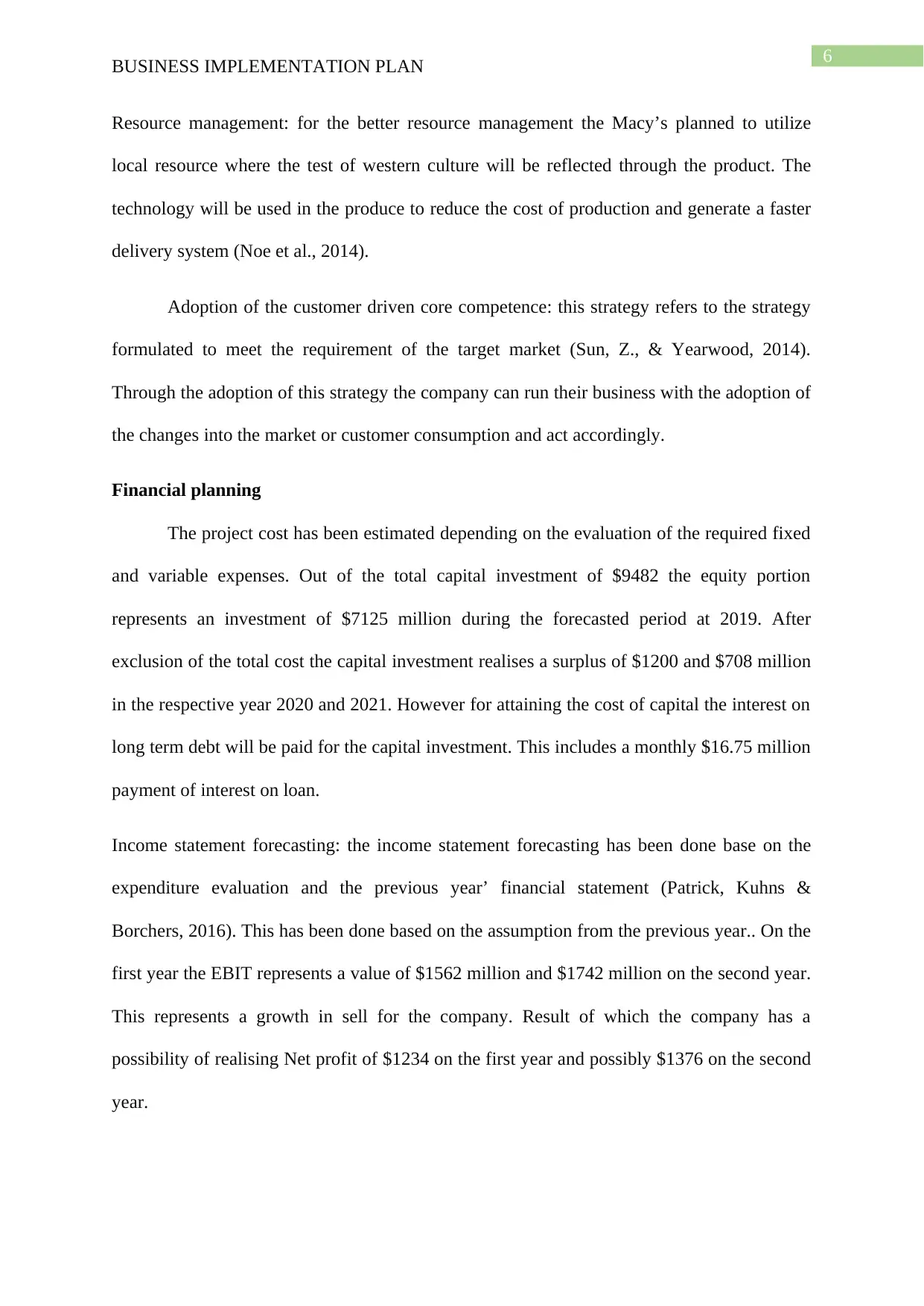
6
BUSINESS IMPLEMENTATION PLAN
Resource management: for the better resource management the Macy’s planned to utilize
local resource where the test of western culture will be reflected through the product. The
technology will be used in the produce to reduce the cost of production and generate a faster
delivery system (Noe et al., 2014).
Adoption of the customer driven core competence: this strategy refers to the strategy
formulated to meet the requirement of the target market (Sun, Z., & Yearwood, 2014).
Through the adoption of this strategy the company can run their business with the adoption of
the changes into the market or customer consumption and act accordingly.
Financial planning
The project cost has been estimated depending on the evaluation of the required fixed
and variable expenses. Out of the total capital investment of $9482 the equity portion
represents an investment of $7125 million during the forecasted period at 2019. After
exclusion of the total cost the capital investment realises a surplus of $1200 and $708 million
in the respective year 2020 and 2021. However for attaining the cost of capital the interest on
long term debt will be paid for the capital investment. This includes a monthly $16.75 million
payment of interest on loan.
Income statement forecasting: the income statement forecasting has been done base on the
expenditure evaluation and the previous year’ financial statement (Patrick, Kuhns &
Borchers, 2016). This has been done based on the assumption from the previous year.. On the
first year the EBIT represents a value of $1562 million and $1742 million on the second year.
This represents a growth in sell for the company. Result of which the company has a
possibility of realising Net profit of $1234 on the first year and possibly $1376 on the second
year.
BUSINESS IMPLEMENTATION PLAN
Resource management: for the better resource management the Macy’s planned to utilize
local resource where the test of western culture will be reflected through the product. The
technology will be used in the produce to reduce the cost of production and generate a faster
delivery system (Noe et al., 2014).
Adoption of the customer driven core competence: this strategy refers to the strategy
formulated to meet the requirement of the target market (Sun, Z., & Yearwood, 2014).
Through the adoption of this strategy the company can run their business with the adoption of
the changes into the market or customer consumption and act accordingly.
Financial planning
The project cost has been estimated depending on the evaluation of the required fixed
and variable expenses. Out of the total capital investment of $9482 the equity portion
represents an investment of $7125 million during the forecasted period at 2019. After
exclusion of the total cost the capital investment realises a surplus of $1200 and $708 million
in the respective year 2020 and 2021. However for attaining the cost of capital the interest on
long term debt will be paid for the capital investment. This includes a monthly $16.75 million
payment of interest on loan.
Income statement forecasting: the income statement forecasting has been done base on the
expenditure evaluation and the previous year’ financial statement (Patrick, Kuhns &
Borchers, 2016). This has been done based on the assumption from the previous year.. On the
first year the EBIT represents a value of $1562 million and $1742 million on the second year.
This represents a growth in sell for the company. Result of which the company has a
possibility of realising Net profit of $1234 on the first year and possibly $1376 on the second
year.
Paraphrase This Document
Need a fresh take? Get an instant paraphrase of this document with our AI Paraphraser
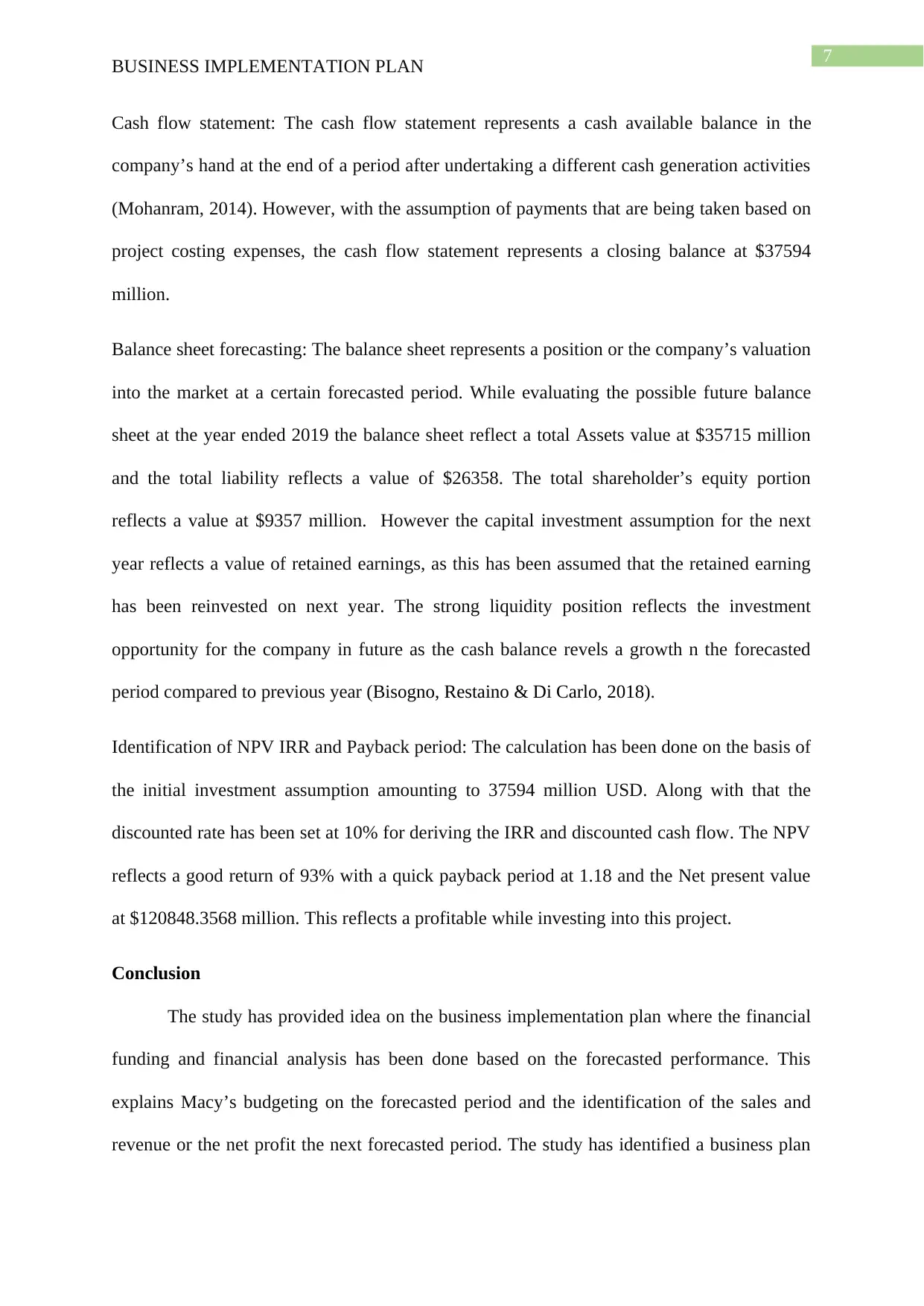
7
BUSINESS IMPLEMENTATION PLAN
Cash flow statement: The cash flow statement represents a cash available balance in the
company’s hand at the end of a period after undertaking a different cash generation activities
(Mohanram, 2014). However, with the assumption of payments that are being taken based on
project costing expenses, the cash flow statement represents a closing balance at $37594
million.
Balance sheet forecasting: The balance sheet represents a position or the company’s valuation
into the market at a certain forecasted period. While evaluating the possible future balance
sheet at the year ended 2019 the balance sheet reflect a total Assets value at $35715 million
and the total liability reflects a value of $26358. The total shareholder’s equity portion
reflects a value at $9357 million. However the capital investment assumption for the next
year reflects a value of retained earnings, as this has been assumed that the retained earning
has been reinvested on next year. The strong liquidity position reflects the investment
opportunity for the company in future as the cash balance revels a growth n the forecasted
period compared to previous year (Bisogno, Restaino & Di Carlo, 2018).
Identification of NPV IRR and Payback period: The calculation has been done on the basis of
the initial investment assumption amounting to 37594 million USD. Along with that the
discounted rate has been set at 10% for deriving the IRR and discounted cash flow. The NPV
reflects a good return of 93% with a quick payback period at 1.18 and the Net present value
at $120848.3568 million. This reflects a profitable while investing into this project.
Conclusion
The study has provided idea on the business implementation plan where the financial
funding and financial analysis has been done based on the forecasted performance. This
explains Macy’s budgeting on the forecasted period and the identification of the sales and
revenue or the net profit the next forecasted period. The study has identified a business plan
BUSINESS IMPLEMENTATION PLAN
Cash flow statement: The cash flow statement represents a cash available balance in the
company’s hand at the end of a period after undertaking a different cash generation activities
(Mohanram, 2014). However, with the assumption of payments that are being taken based on
project costing expenses, the cash flow statement represents a closing balance at $37594
million.
Balance sheet forecasting: The balance sheet represents a position or the company’s valuation
into the market at a certain forecasted period. While evaluating the possible future balance
sheet at the year ended 2019 the balance sheet reflect a total Assets value at $35715 million
and the total liability reflects a value of $26358. The total shareholder’s equity portion
reflects a value at $9357 million. However the capital investment assumption for the next
year reflects a value of retained earnings, as this has been assumed that the retained earning
has been reinvested on next year. The strong liquidity position reflects the investment
opportunity for the company in future as the cash balance revels a growth n the forecasted
period compared to previous year (Bisogno, Restaino & Di Carlo, 2018).
Identification of NPV IRR and Payback period: The calculation has been done on the basis of
the initial investment assumption amounting to 37594 million USD. Along with that the
discounted rate has been set at 10% for deriving the IRR and discounted cash flow. The NPV
reflects a good return of 93% with a quick payback period at 1.18 and the Net present value
at $120848.3568 million. This reflects a profitable while investing into this project.
Conclusion
The study has provided idea on the business implementation plan where the financial
funding and financial analysis has been done based on the forecasted performance. This
explains Macy’s budgeting on the forecasted period and the identification of the sales and
revenue or the net profit the next forecasted period. The study has identified a business plan
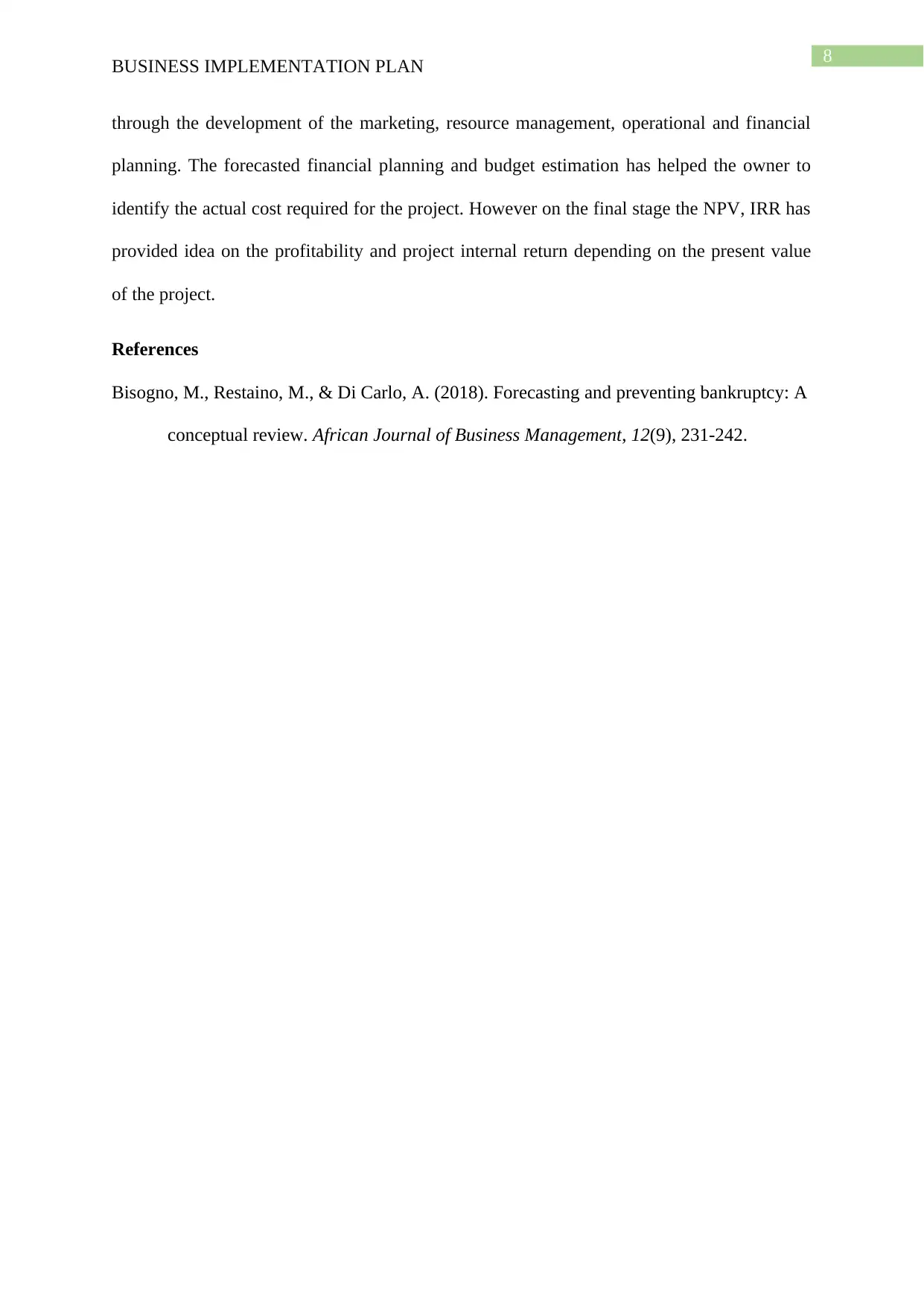
8
BUSINESS IMPLEMENTATION PLAN
through the development of the marketing, resource management, operational and financial
planning. The forecasted financial planning and budget estimation has helped the owner to
identify the actual cost required for the project. However on the final stage the NPV, IRR has
provided idea on the profitability and project internal return depending on the present value
of the project.
References
Bisogno, M., Restaino, M., & Di Carlo, A. (2018). Forecasting and preventing bankruptcy: A
conceptual review. African Journal of Business Management, 12(9), 231-242.
BUSINESS IMPLEMENTATION PLAN
through the development of the marketing, resource management, operational and financial
planning. The forecasted financial planning and budget estimation has helped the owner to
identify the actual cost required for the project. However on the final stage the NPV, IRR has
provided idea on the profitability and project internal return depending on the present value
of the project.
References
Bisogno, M., Restaino, M., & Di Carlo, A. (2018). Forecasting and preventing bankruptcy: A
conceptual review. African Journal of Business Management, 12(9), 231-242.
⊘ This is a preview!⊘
Do you want full access?
Subscribe today to unlock all pages.

Trusted by 1+ million students worldwide
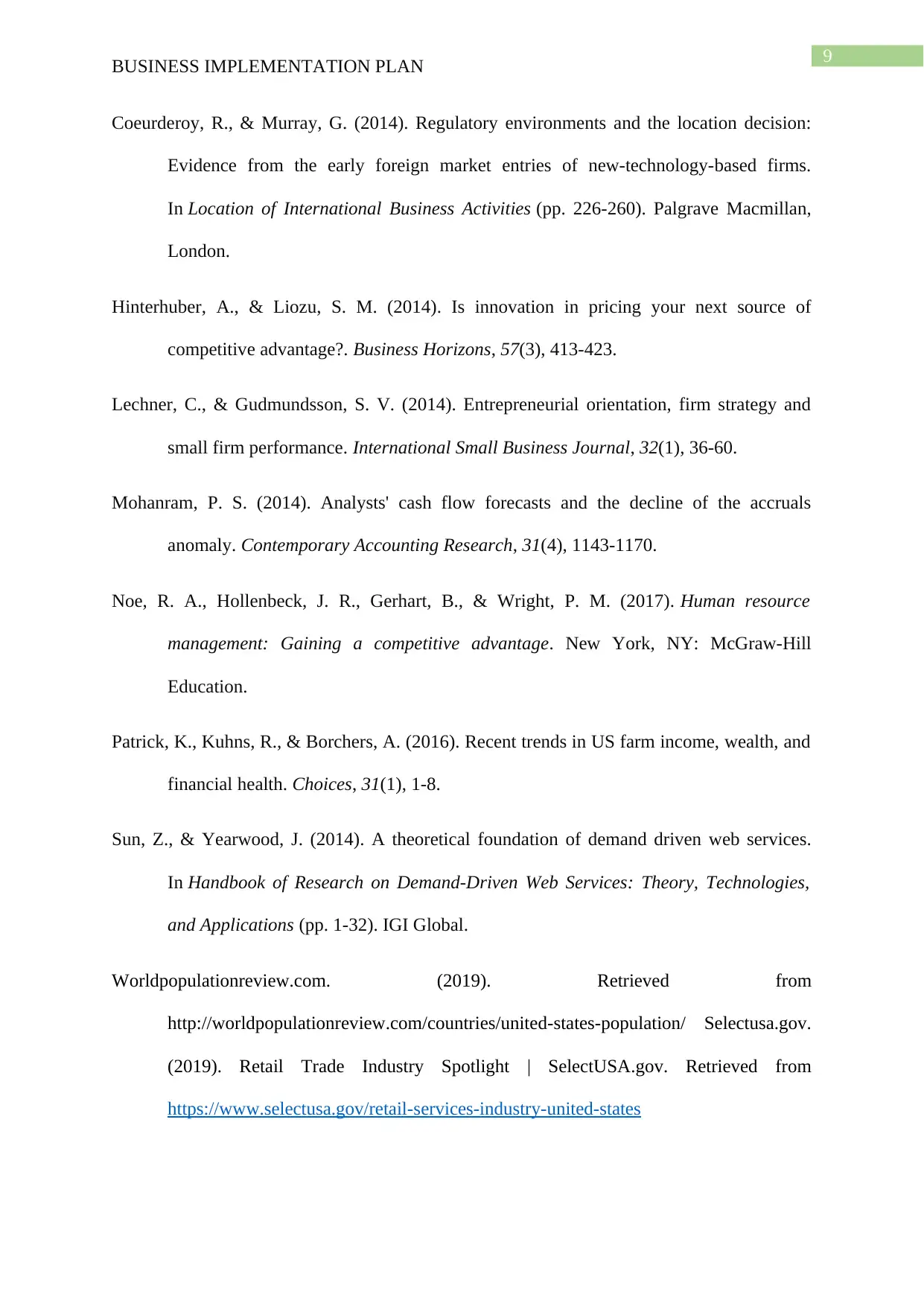
9
BUSINESS IMPLEMENTATION PLAN
Coeurderoy, R., & Murray, G. (2014). Regulatory environments and the location decision:
Evidence from the early foreign market entries of new-technology-based firms.
In Location of International Business Activities (pp. 226-260). Palgrave Macmillan,
London.
Hinterhuber, A., & Liozu, S. M. (2014). Is innovation in pricing your next source of
competitive advantage?. Business Horizons, 57(3), 413-423.
Lechner, C., & Gudmundsson, S. V. (2014). Entrepreneurial orientation, firm strategy and
small firm performance. International Small Business Journal, 32(1), 36-60.
Mohanram, P. S. (2014). Analysts' cash flow forecasts and the decline of the accruals
anomaly. Contemporary Accounting Research, 31(4), 1143-1170.
Noe, R. A., Hollenbeck, J. R., Gerhart, B., & Wright, P. M. (2017). Human resource
management: Gaining a competitive advantage. New York, NY: McGraw-Hill
Education.
Patrick, K., Kuhns, R., & Borchers, A. (2016). Recent trends in US farm income, wealth, and
financial health. Choices, 31(1), 1-8.
Sun, Z., & Yearwood, J. (2014). A theoretical foundation of demand driven web services.
In Handbook of Research on Demand-Driven Web Services: Theory, Technologies,
and Applications (pp. 1-32). IGI Global.
Worldpopulationreview.com. (2019). Retrieved from
http://worldpopulationreview.com/countries/united-states-population/ Selectusa.gov.
(2019). Retail Trade Industry Spotlight | SelectUSA.gov. Retrieved from
https://www.selectusa.gov/retail-services-industry-united-states
BUSINESS IMPLEMENTATION PLAN
Coeurderoy, R., & Murray, G. (2014). Regulatory environments and the location decision:
Evidence from the early foreign market entries of new-technology-based firms.
In Location of International Business Activities (pp. 226-260). Palgrave Macmillan,
London.
Hinterhuber, A., & Liozu, S. M. (2014). Is innovation in pricing your next source of
competitive advantage?. Business Horizons, 57(3), 413-423.
Lechner, C., & Gudmundsson, S. V. (2014). Entrepreneurial orientation, firm strategy and
small firm performance. International Small Business Journal, 32(1), 36-60.
Mohanram, P. S. (2014). Analysts' cash flow forecasts and the decline of the accruals
anomaly. Contemporary Accounting Research, 31(4), 1143-1170.
Noe, R. A., Hollenbeck, J. R., Gerhart, B., & Wright, P. M. (2017). Human resource
management: Gaining a competitive advantage. New York, NY: McGraw-Hill
Education.
Patrick, K., Kuhns, R., & Borchers, A. (2016). Recent trends in US farm income, wealth, and
financial health. Choices, 31(1), 1-8.
Sun, Z., & Yearwood, J. (2014). A theoretical foundation of demand driven web services.
In Handbook of Research on Demand-Driven Web Services: Theory, Technologies,
and Applications (pp. 1-32). IGI Global.
Worldpopulationreview.com. (2019). Retrieved from
http://worldpopulationreview.com/countries/united-states-population/ Selectusa.gov.
(2019). Retail Trade Industry Spotlight | SelectUSA.gov. Retrieved from
https://www.selectusa.gov/retail-services-industry-united-states
Paraphrase This Document
Need a fresh take? Get an instant paraphrase of this document with our AI Paraphraser
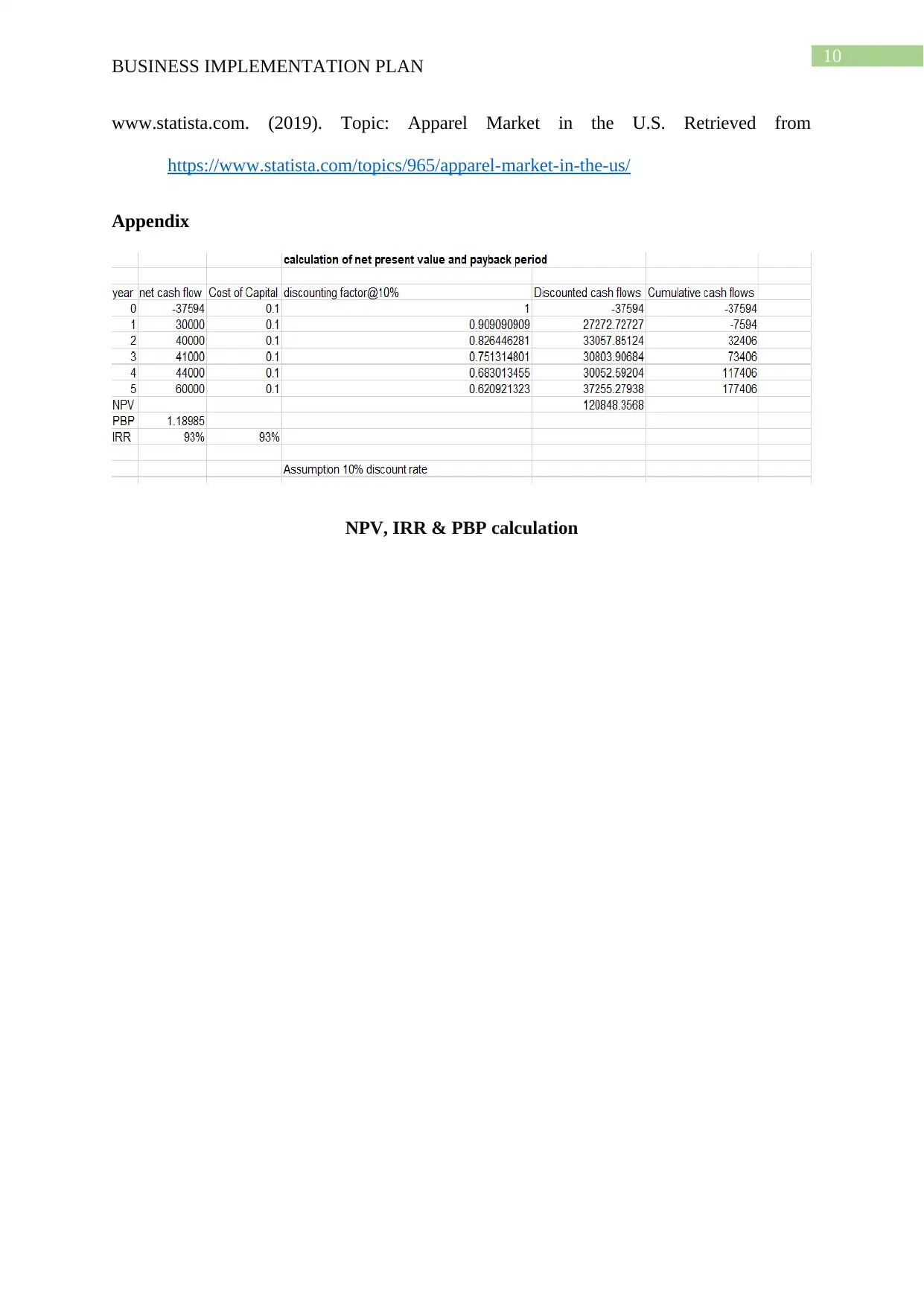
10
BUSINESS IMPLEMENTATION PLAN
www.statista.com. (2019). Topic: Apparel Market in the U.S. Retrieved from
https://www.statista.com/topics/965/apparel-market-in-the-us/
Appendix
NPV, IRR & PBP calculation
BUSINESS IMPLEMENTATION PLAN
www.statista.com. (2019). Topic: Apparel Market in the U.S. Retrieved from
https://www.statista.com/topics/965/apparel-market-in-the-us/
Appendix
NPV, IRR & PBP calculation
1 out of 11
Related Documents
Your All-in-One AI-Powered Toolkit for Academic Success.
+13062052269
info@desklib.com
Available 24*7 on WhatsApp / Email
![[object Object]](/_next/static/media/star-bottom.7253800d.svg)
Unlock your academic potential
Copyright © 2020–2025 A2Z Services. All Rights Reserved. Developed and managed by ZUCOL.





